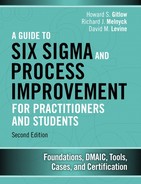Book Description
Master modern Six Sigma implementation with the most complete, up-to-date guide for Green Belts, Black Belts, Champions and students! Now fully updated with the latest lean and process control applications, A Guide to Lean Six Sigma and Process Improvement for Practitioners and Students, Second Edition gives you a complete executive framework for understanding quality and implementing Lean Six Sigma. Whether you're a green belt, black belt, champion, or student, Howard Gitlow and Richard Melnyck cover all you need to know. Step by step, they systematically walk you through the five-step DMAIC implementation process, with detailed examples and many real-world case studies. You'll find practical coverage of Six Sigma statistics and management techniques, from dashboards and control charts to hypothesis testing and experiment design. Drawing on their extensive experience consulting on Six Sigma and leading major Lean and quality initiatives, Gitlow and Melnyck offer up-to-date coverage of:
What Six Sigma can do, and how to manage it effectively
Six Sigma roles, responsibilities, and terminology
Running Six Sigma programs with Dashboards and Control Charts
Mastering each DMAIC phase: Define, Measure, Analyze, Improve, Control
Understanding foundational Six Sigma statistics: probability, probability distributions, sampling distributions, and interval estimation
Pursuing Six Sigma Champion or Green Belt Certification, and more
This guide will be an invaluable resource for everyone who is currently involved in Six Sigma implementation, or plans to be. It's ideal for students in quality programs; "Green Belts" who project manage Six Sigma implementations, "Black Belts" who lead Six Sigma teams; "Champions" who promote and coordinate Six Sigma at the executive level; and anyone seeking Six Sigma certification.
Table of Contents
- Title Page
- Copyright Page
- Dedication
- Contents
- Acknowledgments [This content is currently in development.]
- About the Authors
- Preface
- Section 1: Building a Foundation of Process Improvement Fundamentals
- Section 2: Creating Your Toolbox For Process Improvement
- Chapter 4. Understanding Data: Tools and Methods
- What is the Objective of This Chapter?
- What is Data?
- Types of Numeric Data
- Graphing Attribute Data
- Graphing Measurement Data
- Measures of Central Tendency for Measurement Data
- Measures of Central Tendency for Attribute Data
- Measures of Variation
- Measures of Shape
- More on Interptreting the Standard Deviation
- How to Guide for Understanding Data: Minitab 17 User Guide
- Takeaways from This Chapter
- References
- Additional Readings
- Chapter 5. Understanding Variation: Tools and Methods
- What is the Objective of This Chapter?
- What is Variation?
- Types of Variation
- Using Control Charts to Understand Variation
- Understanding Control Charts
- Rules for Determining Out of Control Points
- Control Charts for Attribute Data
- Control Charts for Measurement Data
- Which Control Chart Should I Use?
- Control Chart Case Study
- How to Guide for Understanding Variation: Minitab User Guide
- Takeaways from This Chapter
- References
- Additional Readings
- Chapter 6. Using Non-Quantitative Techniques: Tools and Methods
- Chapter 7. Overview of Process Improvement Methodologies
- Chapter 4. Understanding Data: Tools and Methods
- Section 3: Putting it All Together—Six Sigma Projects
- Chapter 8. Project Identification and Prioritization: Building a Project Pipeline
- Chapter 9. Overview of Six Sigma Management
- What is the Objective of This Chapter?
- Non-Technical Definition of Six Sigma Management
- Technical Definition of Six Sigma
- Where Did Six Sigma Come From?
- Benefits of Six Sigma Management
- Key Ingredient for Success with Six Sigma Management
- Six Sigma Roles and Responsibilities
- Six Sigma Management Terminology
- Next Steps: Understanding the DMAIC Model
- Takeaways from This Chapter
- References
- Additional Readings
- Appendix 9.1 Technical Definition of Six Sigma Management
- Chapter 10. Dmaic Model: ‘D’ is for Define
- Chapter 11. Dmaic Model: ‘M’ is for Measure
- Chapter 12. Dmaic Model: ‘A’ is for Analyze
- Chapter 13. Dmaic Model: ‘I’ is for Improve
- Chapter 14. Dmaic Model: ‘C’ is for Control
- Chapter 15. Maintaining Improvements in Processes, Products-Services, Policies, and management style
- What is the Objective of This Chapter?
- Improving Processes, Products-Services, and Processes: Revisited
- Two Case Studies of Failure to Maintain Improvements
- A Method for Promoting Improvement and Sustainability
- The Funnel Experiment and Successful Management Style
- Succession Planning for the Sustainability of Management Style
- Egotism of Top Management As a Threat to the Sustainability of Management Style
- Summary
- The Board of Directors Fail to Understand the Need for Sustainability
- In the Organization’s Culture and Management Style5
- Takeaways
- References
- Section 4: Six Sigma Certification
- Chapter 16. Six Sigma Champion Certification at the University of Miami
- Chapter 17. Six Sigma Yellow / Green Belt Certification
- What is the Objective of This Chapter?
- Sample Yellow Belt Certification Examination Questions with Answers
- Time to Get Ready for 10 Days Used to Calculate Variance and Standard Deviation
- 30 Days of Incoming Slide Shipments for a Particular Vendor
- Number of Add-Ons Per Day for 50 Conescutive Days in an Outpatient Clinic
- Turnaround Times for 100 Consecutive GI Biopsy Cases
- Vial Weights for Six Vials Selected During Twenty-Two Time Periods
- Admitting Process Time in Seconds
- Data for Gage R&R Study
- Pharmacy Delay Reasons
- Delay Reasons Pareto Diagram
- Standarized and Revised Best Practice Flowcharts
- Generic Managerial Dashboard
- Project Prioritization Matrix
- Section 5: The Culture Required For Six Sigma Management
